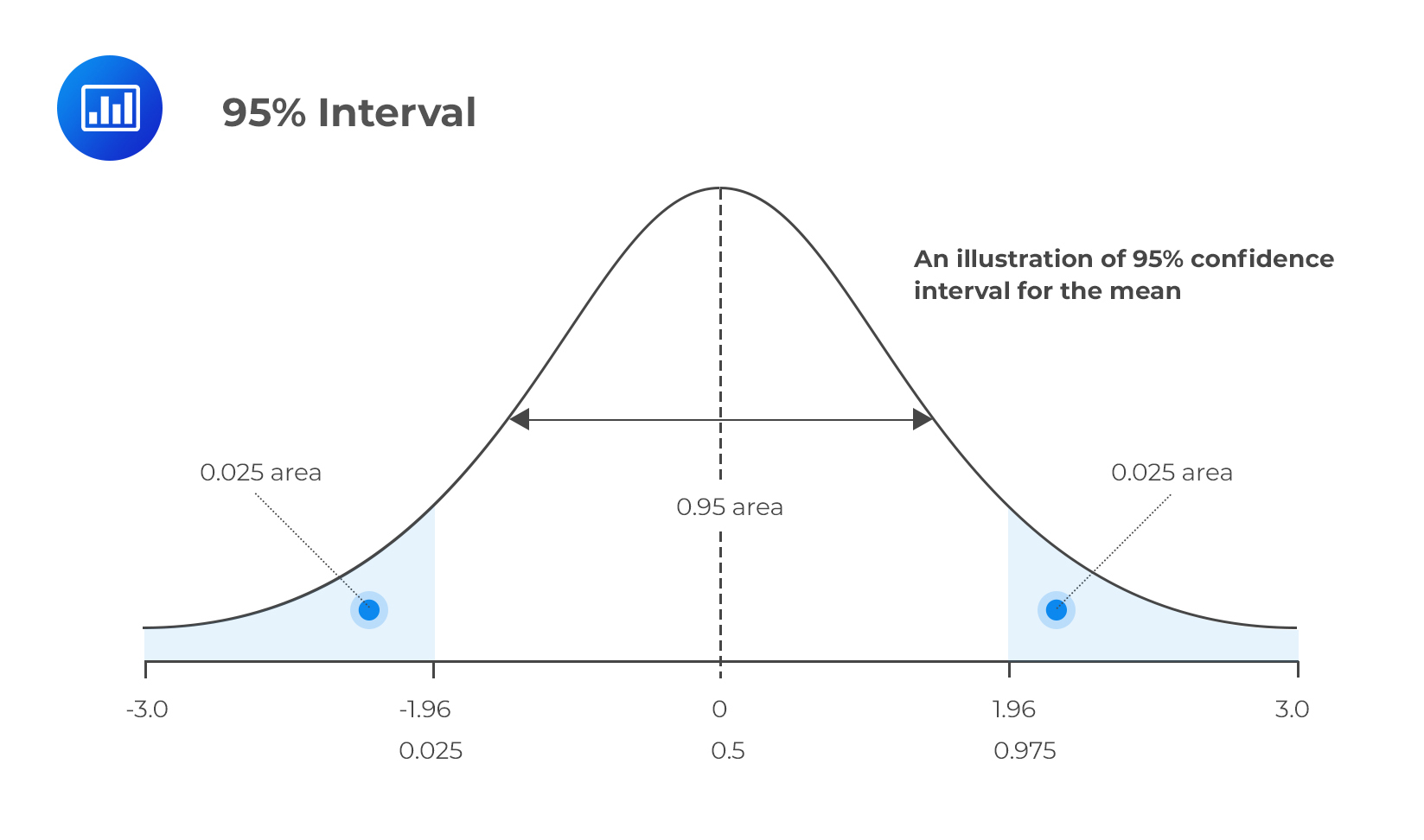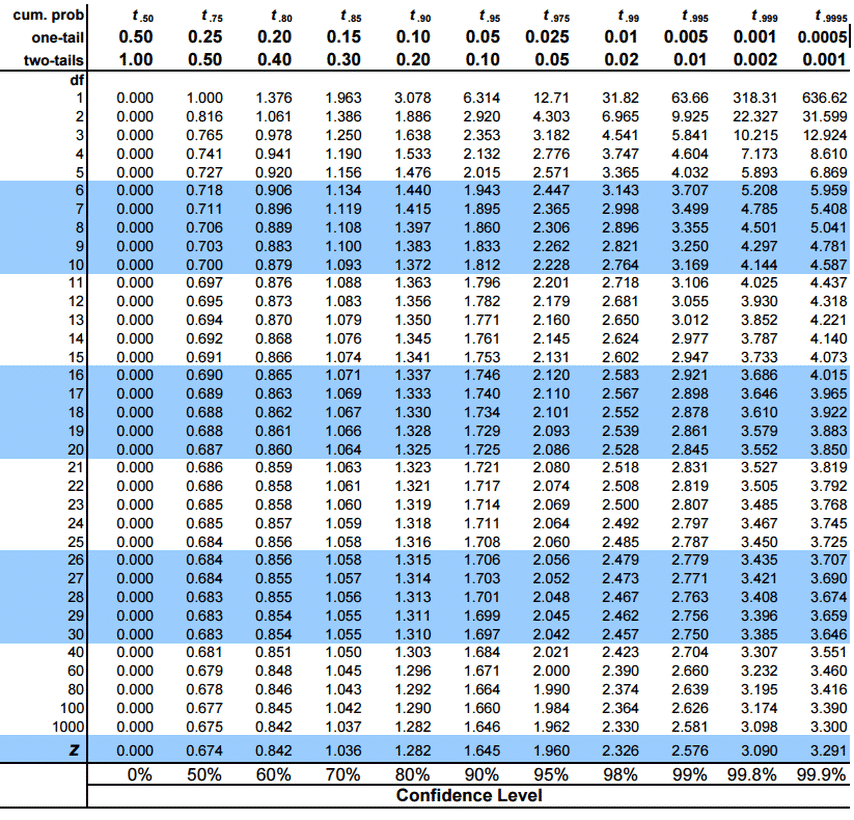Present Values and Future Values of In ...
[vsw id=”mgY_3CHHYBw” source=”youtube” width=”611″ height=”344″ autoplay=”no”]
Confidence interval (CI) refers to a range of values within which statisticians believe the actual value of a certain population parameter lies. It differs from a point estimate which is a single, specific numerical value.
When constructing confidence intervals, we must specify the probability that the interval contains the true value of the parameter of interest. This probability is represented by (1 – α), where α is the level of significance. In statistical terminology, 1- α is called the degree of confidence or certainty.
We define a 100(1 – α)% confidence interval for a given parameter, say θ, by specifying two random variables, θ’1(X) and θ’2(X), such that P{θ’1(X?) < θ < θ’2(X)} = 1 – α.
It happens that α = 0.05 is the most common case in examinations and practice. This leads to a 95% confidence interval.
Consequently, P{θ’1(X) < θ < θ’2(X)} = 0.95 specifies {θ’1(X), θ’2(X)} as a 95% confidence interval for θ. The main task for candidates lies in their ability to construct and interpret a confidence interval. Therefore, the CI for θ above could be interpreted to mean that if we were to construct similar intervals using samples of equal sizes from the same population, then 95% of the intervals would contain the true parameter value. Only 5% would not contain the true parameter value, hence, the phrase “confidence” interval.
To construct a confidence interval, one must come up with an appropriate value that will be subtracted and added to a point estimate. A confidence interval appears as follows:
$$ \text C.\text{I} =\text{point estimate} \pm \text{reliability factor} * \text{standard error} $$
Where:
Point estimate refers to a calculated value of the sample statistic such as the mean, X.
The reliability factor is a value that depends on the sampling distribution involved and (1 – α), the probability that the point estimate is contained in the confidence interval.
$$ \text{Standard error} =\text {Standard error of the point estimate} $$
We can calculate the confidence interval for the mean as,
$$ x \pm z_{\alpha/2} * \frac {\sigma}{\sqrt n} $$
Here, the reliability factor is zα/2. The z-score leaves a probability of α/2 on the upper tail (right-hand tail) of the standard normal distribution.
The following table represents the standard normal distributions commonly used by analysts.
$$ \begin{array}{c|c|c} \text{Degree of confidence} & \text{Level of significance(one-tailed)} & {z_{\alpha/2}} \\ \hline {90\%} & {10\%} & {1.645} \\ \hline {95\%} & {5\%} & {1.960} \\ \hline {99\%} & {1\%} & {2.575} \\ \end{array} $$

When the variance is unknown, we construct the confidence interval for the mean by replacing the z-score in the first scenario with the t-score. Similarly, we replace the unknown σ with S, the standard deviation of the sample mean. Thus,
$$ CI = x \pm t_{\alpha/2} * \frac {S}{\sqrt n} $$
tα/2 is the t-score that leaves a probability of α/2 on the upper tail of the t-distribution. The number of degrees of freedom is determined by the sample size such that the degrees of freedom (df) = n – 1.
Thanks to the Central Limit Theorem, we can approximate just about any abnormal distribution as a normal one, provided the sample size is large (n ≥ 30). Therefore, we can use the relevant z-score when constructing a confidence interval for the population mean.
However, some analysts may advocate using the t-distribution in scenarios where the distribution is abnormal, and the population variance is unknown, even if n ≥ 30. Nonetheless, the use of the z statistic would still be justified under such circumstances, provided the Central Limit Theorem is applied correctly.
A teacher draws a sample of five 12-year-old children from a school’s population and records their heights in centimeters as follows:
$$ \{124, 124, 128, 130, 127\} $$
Assume that the heights have a normal distribution where both μ and σ are unknown. Calculate a two-tailed 95% confidence interval for the mean height of the 12-year-old children.
Solution
Since the variance is unknown and the sample size is less than 30, we should use the t-score instead of the z-score, even if the distribution is normal. Therefore, the confidence interval for the mean will take the form illustrated below.
$$ CI = x \pm t_{\alpha/2} * \frac {S}{\sqrt n} $$
From the data, X = 126.6 and S2 = 6.8
You can read off the t-score value from the t-distribution table where you will find that,
$$ t_{4, 0.025} = 2.776 $$
Please refer to the t-table below to find the critical t-value.

Therefore,
$$ \begin{align*}
CI & = 126.6 \pm 2.776 \times \frac {\sqrt 6.8}{\sqrt 5} \\
& = 126.6 \pm 3.2373 \\
\end{align*} $$
In view of the foregoing, our confidence interval for μ is (123.36, 129.84)
Question
Use data from the example above to calculate a two-tailed 99% confidence interval for the population mean.
A. (125.3, 127.91)
B. (117.9, 135.3)
C. (116.6, 136.6)
Solution
The correct answer is A.
$$ CI = x \pm t_{\alpha/2} * \frac {S}{\sqrt n} $$
$$ t_{4, 0.005 }= 4.604 $$
The other inputs remain the same as in the example above.
Therefore,
$$ \begin{align*}
CI & = 126.6 \pm 4.604* \frac {\sqrt 6.8}{\sqrt 5} \\
& = 126.6 \pm 5.4391 \\
\end{align*} $$The confidence interval for the mean is (121.16, 132.01).
As you might have observed, the interval widens as the level of confidence increases.
Reading 10 LOS 10j:
Calculate and interpret a confidence interval for a population mean, given a normal distribution with 1) a known population variance, 2) an unknown population variance, or 3) an unknown variance and a large sample size.
Get Ahead on Your Study Prep This Cyber Monday! Save 35% on all CFA® and FRM® Unlimited Packages. Use code CYBERMONDAY at checkout. Offer ends Dec 1st.